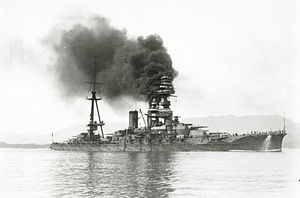
Back Исе (линеен кораб, 1916) Bulgarian Ise (1916) Czech Ise (Schiff, 1917) German Ise (1917) Spanish نبردناو ایسه Persian Ise (1916) Finnish Ise (cuirassé) French Kapal tempur Jepang Ise ID Ise (nave da battaglia) Italian 伊勢 (戦艦) Japanese
 Ise, late 1920s
| |
| History | |
|---|---|
| Name | Ise |
| Namesake | Ise Province |
| Ordered | 11 April 1913 |
| Builder | Kawasaki, Kobe |
| Laid down | 10 May 1915 |
| Launched | 12 November 1916 |
| Completed | 15 December 1917 |
| Stricken | 20 November 1945 |
| Fate | Sunk by air attack, 28 July 1945, and subsequently scrapped |
| General characteristics (as built) | |
| Class and type | Ise-class battleship |
| Displacement | |
| Length | 208.18 m (683 ft) (o.a.) |
| Beam | 28.65 m (94 ft) |
| Draught | 8.93 m (29 ft 4 in) |
| Installed power |
|
| Propulsion | 4 × shafts; 2 × steam turbine sets |
| Speed | 23 knots (43 km/h; 26 mph) |
| Range | 9,680 nmi (17,930 km; 11,140 mi) at 14 knots (26 km/h; 16 mph) |
| Complement | 1,360 |
| Armament |
|
| Armour | |
| General characteristics (after first reconstruction) | |
| Displacement | 42,001 long tons (42,675 t) (full load) |
| Length | 215.8 m (708 ft) |
| Beam | 31.75 m (104 ft 2 in) |
| Draught | 9.45 m (31 ft) |
| Installed power |
|
| Propulsion | 4 × steam turbine sets |
| Speed | 24.5 knots (45.4 km/h; 28.2 mph) |
| Range | 7,870 nmi (14,580 km; 9,060 mi) at 16 knots (30 km/h; 18 mph) |
| Complement | 1,376 |
| Armament |
|
| Armour | Decks: 152 mm (6 in) |
| Aircraft carried | 3 |
| Aviation facilities | 1 catapult |
| General characteristics (as hybrid carrier, 1945) | |
| Displacement | 39,805 long tons (40,444 t) (full load) |
| Length | 219.62 m (720 ft 6 in) |
| Beam | 31.71 m (104 ft) |
| Draught | 9.03 m (29 ft 8 in) |
| Range | 9,500 nmi (17,600 km; 10,900 mi) at 16 knots |
| Complement | 1,463 |
| Sensors and processing systems |
|
| Armament |
|
| Aircraft carried | 22–24 |
| Aviation facilities | 2 catapults |
Ise (Japanese: 伊勢) was the lead ship of her class of two dreadnought battleships built for the Imperial Japanese Navy (IJN) during the 1910s. Although completed in 1917, she played no role in World War I. Ise supported Japanese forces in the early 1920s during the Siberian Intervention in the Russian Civil War. In 1923, she assisted survivors of the Great Kantō earthquake. The ship was partially modernised in two stages in 1928–1929 and 1931–1932, during which her forward superstructure was rebuilt in the pagoda mast style. Ise was reconstructed in 1934–1937, with improvements to her armour and her propulsion machinery. Afterwards she played a minor role in the Second Sino-Japanese War.
Despite the expensive reconstruction, the ship was considered obsolete by the eve of the Pacific War, and did not see significant action in the early years of the war. Following the loss of most of the IJN's large aircraft carriers during the Battle of Midway in mid-1942, she was rebuilt with a flight deck replacing the rear pair of gun turrets to give her the ability to operate an air group of floatplanes; lack of aircraft and qualified pilots meant that Ise never actually operated aircraft in combat. She participated in the Battle off Cape Engaño in late 1944, where she was one of the ships that decoyed the American carrier fleet supporting the invasion of Leyte away from the landing beaches. Afterwards the ship was transferred to Southeast Asia. In early 1945 Ise participated in Operation Kita, where she transported petrol and other strategic materials to Japan. The ship was then reduced to reserve until American airstrikes in July sank her. After the war Ise was scrapped in 1946–1947.
© MMXXIII Rich X Search. We shall prevail. All rights reserved. Rich X Search